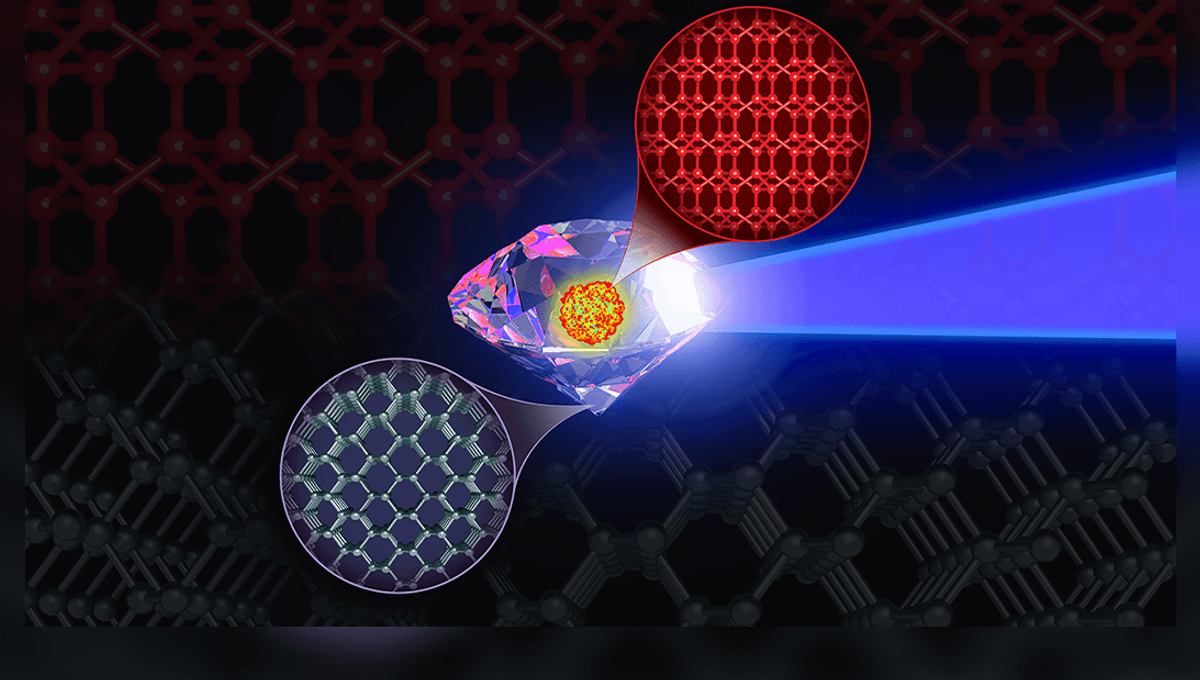
Diamonds are famous as the hardest substances in existence, a status that has recently met with some challenge. In theory, a variation in the way carbon atoms are arranged should make for something harder still, but so far no one has achieved the pressures required to make a so-called “super diamond”. That could be about to change, however, with computer modeling indicating the conditions that might be required.
Diamonds’ strength comes from the way each carbon atom is connected to its four nearest neighbors by covalent bonds creating exceptionally closely packed atoms. Famously, pure carbon atoms can arrange themselves together in many ways, which is why you get materials like buckyballs and graphene.
Debate continues as to whether exotic materials may outdo diamonds using boron nitride, but there is a way to join carbon atoms together that is theoretically stronger than the traditional diamond arrangement. This is known as eight-atom body-centered cubic (BC8) and is estimated to resist compression 30 percent better than ordinary diamonds.
There would certainly be industrial demand for such a material, but it is thought pressures of at least 10 million atmospheres (a trillion Pascals) would be required to form the atoms into such a shape. Once made, however, they should be stable under more normal conditions. Labs have managed to achieve the conditions some previous estimates predicted would produce BC8 diamonds, only to find these were too optimistic, leaving scientists wondering how high pressures would need to go.
If humans have not managed to achieve such extreme conditions to make super diamonds, it might be expected nature would not have either. That’s likely to be true on Earth, but it is thought that some exoplanets (planets orbiting other stars) may be very carbon-rich. The pressures at the center of worlds like these could easily be sufficient for requirements.
“The extreme conditions prevailing within these carbon-rich exoplanets may give rise to structural forms of carbon such as diamond and BC8,” Professor Ivan Oleynik of the University of South Florida said in a statement. “Therefore, an in-depth understanding of the properties of the BC8 carbon phase becomes critical for the development of accurate interior models of these exoplanets.”
BC8 can also exist in silicon and germanium, the elements immediately below carbon on the periodic table, and these have been produced. Using what we know about its production in these elements, Oleynik and colleagues have created computer models to explore what would be required to make it happen in carbon.
The calculations involved are immense, but using Frontier, the world’s fastest exascale supercomputer, the team thinks they have identified what would be required to make billions of atoms join together in the way desired. “We predicted that the post-diamond BC8 phase would be experimentally accessible only within a narrow high-pressure, high-temperature region of the carbon phase diagram,” Oleynik said.
Specifically, pressures of 1,050,000,000,000 Pascals would be required at a precise temperature, probably around 6,000 K. Even higher pressures would widen the potential temperature range, but not by a lot. To get there, the program predicts ordinary diamonds would melt into a metastable supercooled carbon liquid, from which BC8s would form. Like ice particles in supercooled water, BC8 crystals would have great trouble getting started, but once one formed, would grow quickly by nucleation.
Whether any equipment on Earth is up to the challenge of making this happen remains to be seen.
If it can, the authors think BC8 carbon may do more than simply exceed diamonds’ resistance to pressure. “The BC8 structure maintains this perfect tetrahedral nearest-neighbor shape, but without the cleavage planes found in the diamond structure,” said co-author Dr Jon Eggert of the Lawrence Livermore National Laboratory. Despite the immense costs of making something like this, that toughness could prove invaluable, as well as offering lessons about the internal workings of planets with such cores.
The study is published in The Journal of Physical Chemistry Letters.
Source Link: Supercomputer Cracks How To Create Material Harder Than Diamond: The “Super Diamond”